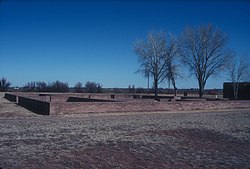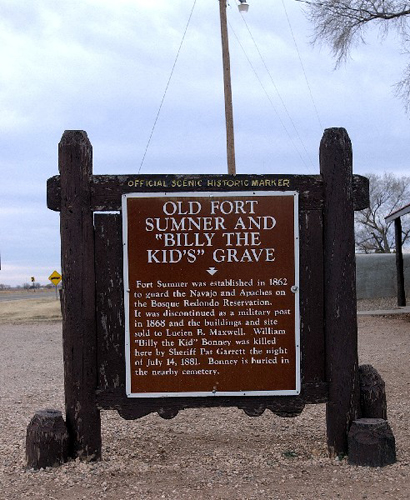Fort Sumner
Bosque Redondo (Spanish: Round Grove ) a camp in southeastern New Mexico was named in which the U.S. government was 1863-1868 detain more than 8,500 Diné and 500 Mescalero Apaches over the years.
On 31 October 1862, the construction of Fort Sumner was adopted by the Congress of the United States. General James Henry Carleton had the construction of the fort advocated to ensure the protection of the settlers in the valley of the Pecos River in front of the resident Indian tribes. Nearby lay the territory of Bosque Redondo, an area of approximately 100 km ² along the Pecos River. The camp had been set up to show the Indians how you could feed by farm work. However, it soon turned out that there was firewood in Bosque Redondo neither enough water. Nevertheless, Colonel Kit Carson was ordered to bring in 1862 the Mescalero and by the end of 1864, according to Bosque Redondo Diné. This 450 km long wretched group from the homeland of the Diné in northern Arizona and New Mexico Bosque Redondo after went down in the history of the American Southwest as Long March (English Long Walk ).
The government had expected about 5,000 residents of the camp, but now there were about 9,000 Indians arrived and there were soon problems with the supply. Those who had survived the Long March, found themselves on a desolate strip alkaline, sandy land along the Pecos River. Most of the trees of the grove round had to cut down to build the adjacent Fort Sumner. The Diné lifted trenches and holes made in the ground, to protect themselves against sun, wind and cold. The little wood was burned quickly and the Indians had to walk miles to dig Mesquitewurzeln who used it as firewood. In addition, the alkaline waters of the Pecos River was almost inedible.
Soon broke out bloody conflicts between Diné and Mescalero Apaches, who were enemies since ancient times. Under the supervision of the white guards the Indians raised about 50 km of irrigation ditches, plowed 800 acres of land and built mainly on corn at. However, pests and drought resulted in the following two years to crop failures and in the third year of the Pecos River overflowed its banks and destroyed the irrigation ditches. Meanwhile, the Mescalero had left the camp in 1865 without permission. They received in 1873 after long negotiations with the government, a reserve further south in New Mexico.
Hundreds of Indians died of diseases and care and after three years, characterized by poor harvests and the flight of many desperate residents, it became apparent that Carleton's plan had failed and the Diné demanded to return to their traditional tribal lands. The U.S. government commissioned General William Tecumseh Sherman to investigate the situation in Bosque Redondo and he was shocked by the prevailing conditions. On June 1 1868 signed Diné chiefs in Fort Sumner a contract in which the government allotted them a sanctuary in the old country and the tribe approved the return. Also, thousands fled Diné joined the returnees.
1968, one hundred years after the signing of the contract, to Fort Sumner New Mexico State Monument was declared. In 2005 was opened on the site of a new museum, designed by Navajo architect David Sloan. It bears the name Bosque Redondo Memorial ( Memorial to Bosque Redondo ).










